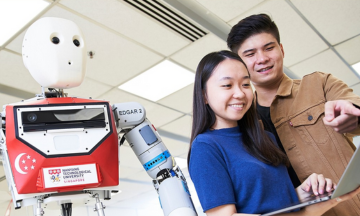Social Robot & Human-Robot Interaction

The objective is to leverage multi-modal human-guidance to improve the learning efficiency and continuous learning ability of reinforcement learning agents.
- Human-in-the-Loop Deep Reinforcement Learning (DRL) for AVs
- Human-guided DRL for continual learning
Principal Investigator: Associate Professor Lyu Chen
The objective is to develop bi-directional augmented collaboration framework, for achieving safer and robust human-machine systems.
- Human-machine collaboration for highly automated vehicles
- Remote collaboration for deployment of robots in society
Principal Investigator: Associate Professor Lyu Chen
The objective is to create multi-modal artificial skins that can respond to various tactile or touchless signals, which can be applied in robotic sensing and perception.
Principal Investigator: Assistant Professor Wang Yifan
Traditional AI models predominantly rely on a single modality, limiting their adaptability and robustness. This research area focuses on developing multimodal foundation models that integrate diverse sensor inputs—such as vision, language, and action signals—to enhance perception, reasoning, and decision-making. By leveraging large language models (LLMs) and Vision-Language-Action (VLA) models, robots and AI systems can understand and interact with the world more effectively, improving their ability to generalise across diverse environments and tasks.
Principal Investigator: Assistant Professor Yang Jianfei
Data-Driven Robotic Linkage Design Leveraging Generative AI (GenAI)
GenAI presents great potential to efficiently design complex and optimized robotic linkage mechanisms, which is challenging for humans.
Advancing Robotic Design Through Topology Optimization and Generative AI (GenAI)
Topology optimization is crucial in robotic design: Lightweight Structures, Material Efficiency, Improved Mechanical Performance, Customization for Specific Applications, Integration with Additive Manufacturing, Enhanced Motion and Dynamics, and Cost Reduction, etc. Integrating physics-based topology optimization and GenAI can significantly improve performance and computational efficiency.
Principal Investigator: Assistant Professor Song Binyang
AI-Driven Drone Fleet Design and Operations for Small Parcel Delivery
Improve delivery efficiency and lower the cost by designing and operating a drone through developing a generative AI (GenAI) for drone configuration design, a path planning AI to create operations plans, and an edge AI to make real-time control decisions.
Designing Interactive and Adaptable Robots for Enhanced Human-Robot Collaboration
- Adaptable robots tailored for different users, enabling scalable customization and personalization
- Large Language Model (LLM)-based Human-Robot Interaction
Principal Investigator: Assistant Professor Song Binyang

